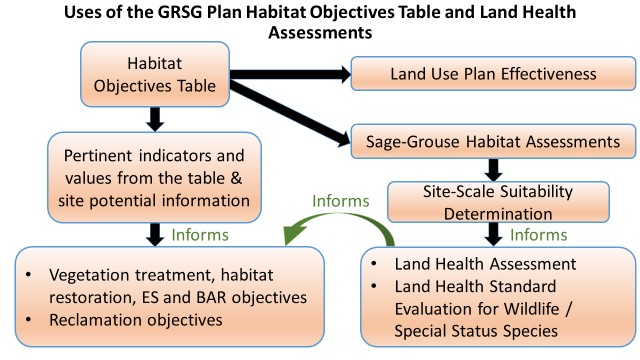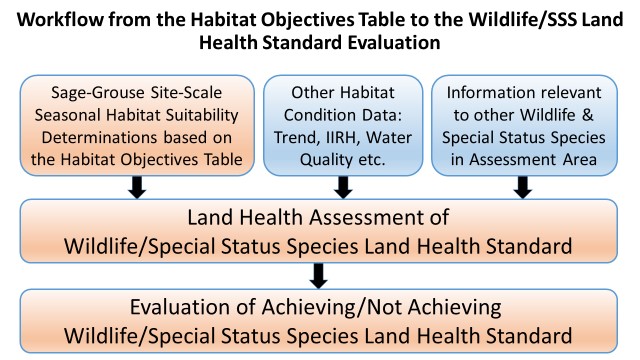Implementation of the Habitat Objectives Table from the 2015 Greater Sage-Grouse Approved Resource Management Plans and Amendments
UNITED STATES DEPARTMENT OF THE INTERIOR
BUREAU OF LAND MANAGEMENT
WASHINGTON, D.C. 20240
December 27, 2017
Reply Refer To:
1610 (200), 6710, 4110 P
EMS Transmission: December 27, 2017
Instruction Memorandum No. 2018-25
Expires: 09/30/2021
To: State Directors (California, Colorado, Idaho, Montana, Nevada, Oregon/Washington, Utah, and Wyoming) and Center Directors
From: Assistant Director, Resources and Planning
Subject: Implementation of the Habitat Objectives Table from the 2015 Greater Sage-Grouse Approved Resource Management Plans and Amendments
Program Areas: Wildlife Management, Threatened and Endangered Species Management, Rangeland Management, Riparian Management, Hazardous Fuels Management, Emergency Stabilization, Burned Area Rehabilitation, Resource Management Planning.
Purpose: This Instruction Memorandum (IM) provides guidance on the use of the Habitat Objectives Tables (often referred to as Table 2-2) in each of the 2015 Greater Sage-Grouse (GRSG) Approved Resource Management Plans and Amendments (GRSG Plans), including using the existing indicator values in the tables or, when supported by the best available GRSG science, alternative indicator values that represent the seasonal habitat needs of GRSG.
Policy/Action: The BLM offices should use the Habitat Objectives Table indicators and values found in their GRSG Plan in assessing site-scale suitability of GRSG habitat. These results inform the Land Health Standards (LHS, 43 CFR 4180.2) assessment and evaluation process. The LHS evaluation can inform potential management actions. Offices should also use the Habitat Objectives Table indicators and values as a component of GRSG Plan effectiveness evaluations to describe the change from the baseline vegetation conditions (the conditions at the onset of a monitoring program) to the time of the next monitoring interval. Appropriate indicators from the Habitat Objectives Table can also be used to develop measurable objectives for vegetation treatments and management actions within sage-grouse habitat areas. The BLM offices are to follow the process identified herein when considering whether to utilize values other than those in the GRSG Plan Habitat Objectives Table.
Uses of the GRSG Plan Habitat Objectives Table (See Diagram 1)
● To assess site-scale suitability of sage-grouse habitat following current BLM policy on Gunnison and Greater Sage-Grouse (including the Bi-State Distinct Population Segment) Habitat Assessment Policy.
● To inform Land Use Plan (LUP) effectiveness to conserve GRSG habitat.
● To develop measurable objectives for projects in sage-grouse habitat areas.
Diagram 1: Uses of the GRSG Plan Habitat Objectives Table and the Land Health Assessments.

Using the Habitat Objectives Table in Site-Scale Habitat Assessments
Each seasonal habitat indicator value in the Habitat Objectives Table is compared to data collected at each plot (during the appropriate season) in GRSG habitat. Then the indicators for the seasonal habitat will be examined using a preponderance of evidence approach (Pellant et al. 2005, BLM TR 1734-6) to determine overall suitability (suitable, unsuitable, or marginal) of the plot. No single indicator from the habitat objectives table should be used by itself to determine site-scale suitability of sage-grouse habitat. It is critical to document certain environmental factors, such as drought conditions and the ecological site potential on the site-scale suitability forms (modified as necessary from the Sage-Grouse Habitat Assessment Framework (HAF, BLM TR 6710-1, Stiver et al 2015)), so that the documentation can be used in the LHS evaluations and determination of causal factors if a standards are is not achieved. This approach is consistent with the BLM’s Habitat Assessment Policy for Gunnison and Greater Sage-Grouse (including the Bi-State Distinct Population Segment).
During the LHS evaluation, the long-term trends should be used in addition to the sage-grouse habitat suitability determinations (see Diagram 2). Sage-grouse habitat assessments help to inform the BLM’s land health evaluation for Special Status Species, but are not a substitute for long-term trend data and rangeland health assessment monitoring. The process for Grazing Permit Renewals has not changed. Standards for Rangeland Health must be achieved, maintained, or significant progress towards achievement must be shown. The Land Health Assessment and LHS evaluation tasks, including sage-grouse habitat assessments, should not be viewed as, or completed as, separate workloads. These are all components of the current BLM regulatory requirements of achieving LHS. Whenever possible, complete these tasks simultaneously.
Diagram 2: Workflow from the Habitat Objectives Table to the Wildlife/SSS Land Health Standard Evaluation

Inappropriate Uses of the Habitat Objectives Table
- Using the indicator value(s) as default desired conditions to inform LUP effectiveness without considering the ecological potential of the site and relevant local information where measurements were taken.
- Using a single measured indicator value to determine sage-grouse habitat suitability.
- Using a single indicator as a criterion to modify grazing management or any other use.
- Adjusting use authorizations based on measured indicator values without adequate monitoring data and a causal factor determination.
Using Site-Specific Indicator Values
Not all areas within a given habitat management area will be capable of meeting the desired seasonal habitat values in the Habitat Objectives Table due to inherent variation in vegetation communities and ecological potential. Further, local data or recent science may indicate that sage-grouse select for vegetation structure and composition in seasonal habitats not characterized by the values in the Habitat Objectives Table. In these cases, it may be appropriate to utilize values other than those in the Habitat Objectives Table. The BLM State Offices should follow these steps when evaluating whether to use alternative values to those found in the Habitat Objectives Table:
Step 1: Evaluate the data and science against the following criteria:
- Data accurately describes the seasonal habitat selection criteria of a GRSG population and is supported by peer-reviewed science.
- The analysis used to evaluate the data and its relationship to suitable habitat is available to the public.
- A change in indicator value is detectable (so that trend can be detected over time).
- The values have been reviewed and accepted by the state wildlife agency, if the agency elects to participate.
Step 2: If the BLM State Office determines that the habitat values identified in Step 1 are appropriate for a seasonal habitat area, the state office should document the alternate indicator value(s) through the appropriate mechanism (e.g., policy or LUP action). The documentation for the new information must clearly describe the data sources and science used to reach the adjusted value(s).
Step 3: Offices should use the new indicator values that are appropriate for the seasonal habitat area and include documentation supporting the new indicator values in the applicable assessment report (e.g., site-scale suitability form, LHS evaluation, plan effectiveness).
Timeframe: This policy is effective immediately.
Budget Impact: Current budget supports the fieldwork to collect core indicator data to inform the indicators in the Habitat Objectives Tables and perform assessments and evaluations of habitat condition and LUP effectiveness. Current budgets are also supporting development and delivery of training on appropriate use of the GRSG Habitat Objectives Table.
Background: Sage-grouse have a fairly specific set of habitat parameters that research has shown are important to its conservation. The BLM's overarching goal is to have healthy, intact sagebrush steppes that are achieving or making progress towards achieving LHS, including the wildlife/special status species habitat standard and that provide for the long-term sustainability of rangelands for livestock grazing, wildlife habitats, and other uses.
The process for Land Health Assessments has not changed. Standards for Rangeland Health must be achieved, maintained, or significant progress towards achievement must be shown. Current guidance is found in the BLM 4180 Handbook (BLM 2001). When the BLM applies land health standards to assess land health, they are applied regardless of use. If rangelands are meeting all applicable LHS, adjustments to uses are typically unnecessary. If the BLM determines that rangelands are not meeting the standards of land health, then the BLM should determine the causal factors and implement appropriate management actions to ensure the area is making significant progress toward achieving the standards. When authorizing these appropriate management actions, the BLM should implement a monitoring plan to determine if the actions are accomplishing the desired result.
The ecological potential of a site is informed from an Ecological Site Description, associated State and Transition Models, and other pertinent data used to complete a Reference Sheet as described in Interpreting Indicators of Rangeland Health (M. Pellant, et. al,. 2005). The ecological potential indicates whether a site can achieve the values for the indicators in the Habitat Objectives Table. If an Ecological Site Description or associated State and Transition Model are not available, the process set out in Interpreting Indicators of Rangeland Health describes a process to identify an existing Ecological Site Description that is suitable for the soil, moisture, aspect, and slope of the site in question. If no comparable or suitable Ecological Site Description is available,Interpreting Indicators of Rangeland Health also describes the process to develop a Reference Sheet in the absence of an Ecological Site Description.
On August 4, 2017, the BLM delivered a Response to Secretarial Order 3353 “Greater Sage-Grouse Conservation and Cooperation with Western States” (June 7, 2017) that identified issues related to the 2015 GRSG plans and subsequent policies. This policy revision is a result of the Response to SO 3353 as well as feedback from internal staff and external federal, state, and local partners.
Coordination: This IM was coordinated between the WO Division of Fish and Wildlife Conservation, the WO Division of Forest, Rangeland, Riparian and Plant Conservation, the Division of Resource Services at the National Operations Center, and state directors within GRSG habitat.
Contact: For further information or clarification, please contact: Vicki Herren (National Sage-Grouse Coordinator at 202-912-7235 or by email at [email protected]), Kimberly Hackett (Senior Natural Resource Specialist at 202-912-7216 or by email at [email protected]) or Gordon Toevs (Senior Policy Advisor, Resources and Planning at 202-567-1589 or by email at [email protected]).
Signed by:
Kristin M. Bail
Assistant Director, Resources and Planning
Authenticated by:
Catherine Emmett
WO-870, IT Policy and Planning
